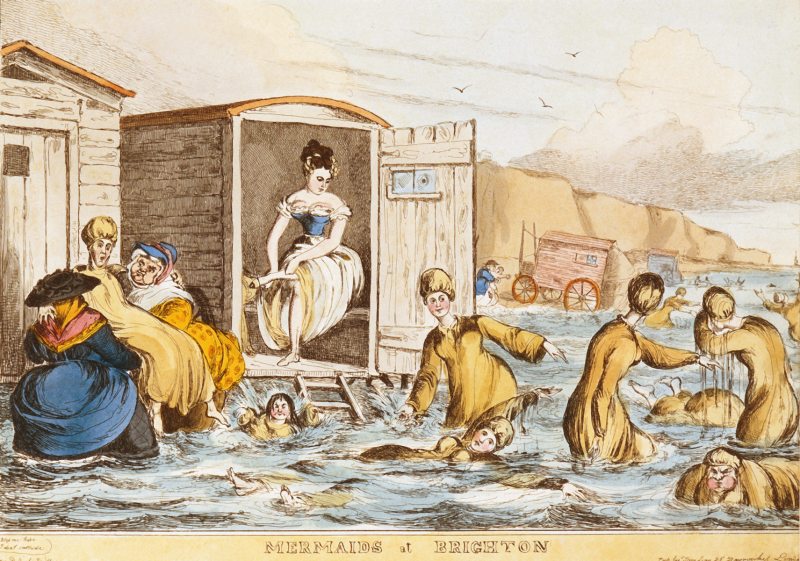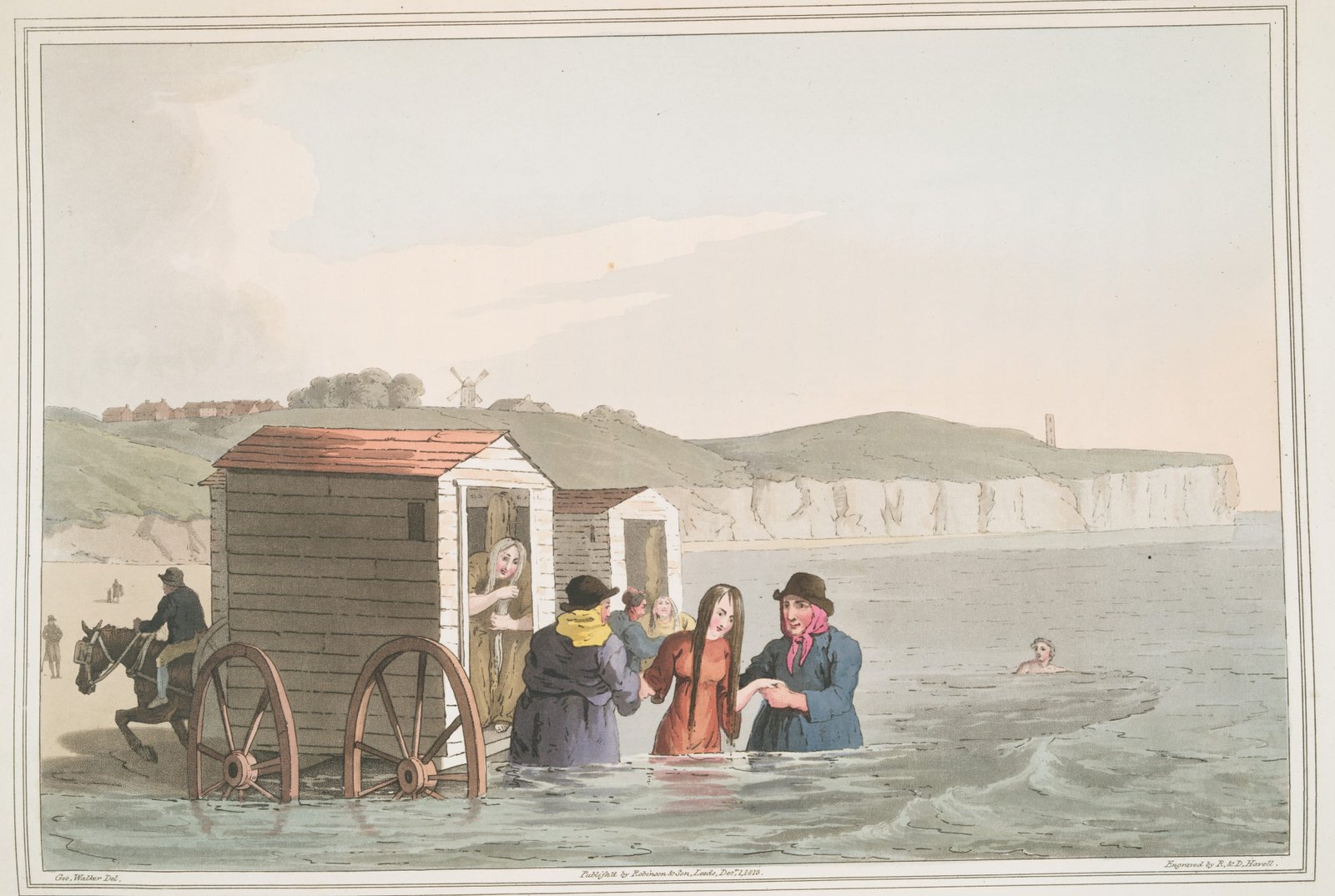Sea-bathing Done Correctly

A Little Sea Bathing

As with most things in life, sea-bathing in Austen’s day needed to be done correctly in order to derive the most benefit. Entire books were devoted to the subject.
The anonymous work, The Hand-Book of Bathing, written by the author of the Hand-Book of the Toilette notes: “many popular mistakes exist with reference to the amusement of sea-bathing” and provided readers with a ready guide of why and how to properly sea bathe.
Cold Water Most Beneficial
He begins by specifying that cold water bathing is particularly beneficial.
The advantage obtained from cold bathing by persons in health, as well as by invalids, is a shock on the system produced by the action of the cold water, which drives the blood from the skin, and by the reaction, brings it back again immediately to the surface, by which means the body glows with warmth so long as this reaction takes place. No longer than this is the cold bath beneficial; the moment the reaction ceases it is because the system had no longer the strength to produce it.
(The handbook of bathing, pg 103)
He goes on to note (thankfully) that too much cold water can be deleterious to individuals and should be avoided. (Is anyone else thinking hypothermia here?) As such, September was an ideal time for sea-bathing, even up to November could be acceptable. From November to April though, he recommended avoiding sea-bathing, especially along northern beaches, as it was too cold. Similarly, bathers should not not sea-bath oftener than every other day, using cold or tepid sponge baths on the days between, with the application of coarse towels or skin brushes afterwards.
(Considering how much I detest cold water, I can not image getting into the ocean in September, much less November, despite the fact I live on the Texas Gulf Coast!)

He recommends that the best hour for sea bathing, for the healthy individual was directly after rising. For those more delicate, he suggests 2 ½- 3 hours after an early breakfast, around 10-11AM, when the water was warmer. But he cautioned that one should not enter the water immediately after eating lest the blood that should be going to the stomach be diverted to the skin and disrupt digestion.
Dipping rather than Swimming
In light of the danger of too much cold water, the author recommended not more that five minutes in the cold water. (I found this a little surprising, considering how much effort had to be made to get out into the water.) Specifically, a “couple of good dips” for ladies, followed by a vigorous rubbing of the skin with a coarse towel, skin brush or flannel, after drying off but before getting dressed in the bathing machine, then a brisk walk home would provide the greatest benefit.
Interestingly, he did not advocate swimming as a wise practice and did not believe that English ladies would ever take to the amusement.
I should say that swimming causes too much exhaustion, and opens the road to too many dangerous consequences, for people to adopt it as a healthy or health-bearing exercise. It is a passion, a sport, an amusement; and as such may be classed with other exhausting or dangerous sports, such as a steeple -chase, or a foot-race, or a walking – match against time, or a tiger hunt, or that fatal exercise of rowing and boat-racing practiced at Cambridge, which has destroyed many a promising youth, and unexpectedly brought bereavement and mourning upon a parent rendered childless, or upon an orphan sister now without a protector. Swimming, then, should not be indulged in to excess; and even for a robust person, half an hour’s exertion of this nature will be found sufficient.
(The Handbook of bathing, pg. 118)
Recommendations for Bathing Machines and Dippers

Of both the bathing machines and dippers necessary for sea-bathing, he offered some very strong and a few oddly specific opinions.
The interior of a bathing – machine ought to be fitted up with as much care, and contain as many conveniences, as the bathing – rooms at the public baths in London. The floor should be carpeted, and a small closet divided off from the landing place to which the ladder is affixed, communicating with the little room by a door covered with green baize, and lighted by a small lateral window. The lady who bathes having ascended from the water to the landing -place, should enter the closet, be immediately divested of her bathing-dress and cap, put her feet into a pair of dry lamb’ -wool slippers, and be wholly enveloped in a thick cotton dressing gown, very dry, which she should bring with her. She should now enter the carpeted room, and seat herself upon an easy-chair or sofa, which should be there, with a footstool. Her legs and feet should be first rubbed till they are in a glow; then her neck, back, and arms, and successively her whole body, … and terminating either with a flesh-brush or with a roll of flannel (formed for the purpose. Dressing should now be as speedily effected as possible.
(The Handbook of bathing, pg. 107-108)
He also expressed a great deal of concern about the conduct of the dippers themselves. (Which I can completely understand as I’d be rather concerned about someone I paid to ensure I submerged myself in cold water!)
The coarse brutality of the bathing-women, in dipping the bathers, is sometimes productive of considerable evil; and where nervous timidity has existed in a bather, this sort of conduct has sometimes raised an alarm in the patient fraught with a thousand times more mischief than the amount of benefit yielded by the bath itself…. During my experience, I have known many a poor girl and boy, weak, sickly, nervous – starting at a sound or a shadow – when seated trembling on the steps of the bathing machine, afraid either to advance or recede, suddenly and unexpectedly pulled down head foremost by the brutal female attendant, and soused in the water with just as much unconcern and absence of tenderness, as if she were dipping a whelp. … The women who attend upon ordinary female bathers in the machines, should be persons of kind, soothing, and persuasive manners. … If, then, ordinary bathers, in good health, require in their bathing attendants the qualities I have mentioned, what must be the case with invalid bathers, to whom the least oversight is a vehicle of mischief, the least roughness a cause of pain and alarm, and to whom a word or a look skillfully applied often brings relief! For such persons, the bathing-women should possess all the qualities of the best hospital nurses: … and, above all, a great deal of tact, or, in plainer words, of “mother wit.” … A woman known to the bathers as being thus gifted would obtain such preference, that she would soon realize an humble fortune.
(The Handbook of bathing, pg. 127-128)
I have to admit he makes a good point here.
A Final Bit of Advice
In parting, I leave you with a final bit of advice author offers to assist with a common complaint of ladies, both then and now.
Ladies always fear to wet their hair, from the difficulty of drying it. But I think that if … the water were allowed to wet the head twice a week, the action of the salt water would prove very beneficial, and prevent the hair from falling off. After the bath, the hair should be wrung and wiped as dry as possible with towels. … until as much of the moisture as possible is absorbed, when it may be dried by the following process, which occupies but a few instants. The body reclines upon a sofa or ottoman, over one extremity of which the wet hair hangs loose. Under the hair is placed either a fire-shovel, or a pan, or a chafing dish, with two or three bits of lighted charcoal. A pinch of powdered benzoin [a gum resin from trees of styrax family] is thrown upon the ignited charcoal, when a thick smoke arises, to receive which equally, the hair is spread open by the attendant maid. In a few seconds the hair becomes quite dry, and is impregnated besides with an agreeable perfume
(The Handbook of bathing, pg. 105-106)
I’m sure you’ll all agree, drying your (long) hair over lit coals sounds like an excellent idea. (And in the back of my head I hear the TV announcer saying ‘This week on A Thousand Ways to Die…). What do you think?
Reference
The hand-book of bathing. 1841. London: William S. Orr & Co. Paternoster Row.

Do mothers still warn their children not to go swimming after they eat, because they’ll get cramps? That was certainly the wisdom back in the day, and it’s referenced here!!
Those pictures are hilarious. Sometimes after a warm shower, I will lower the warm water until I can feel the cool but not shockingly cold water. I’ve heard that is very efficacious to one’s health. LOL! Thanks for sharing.